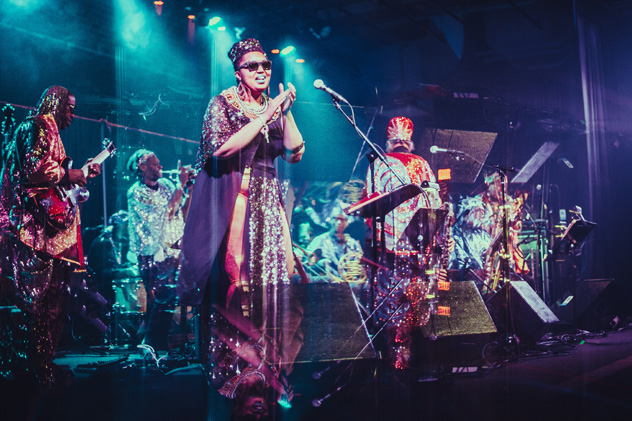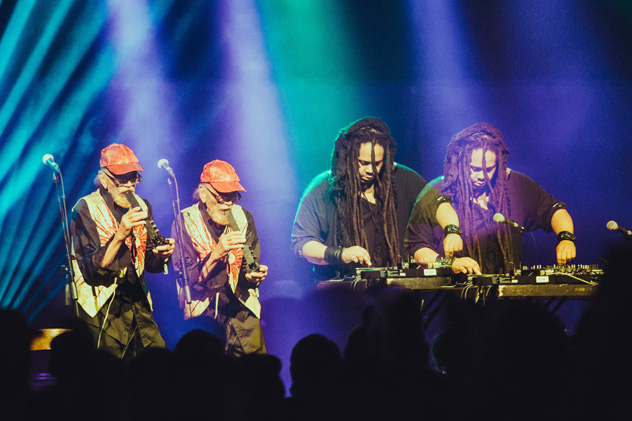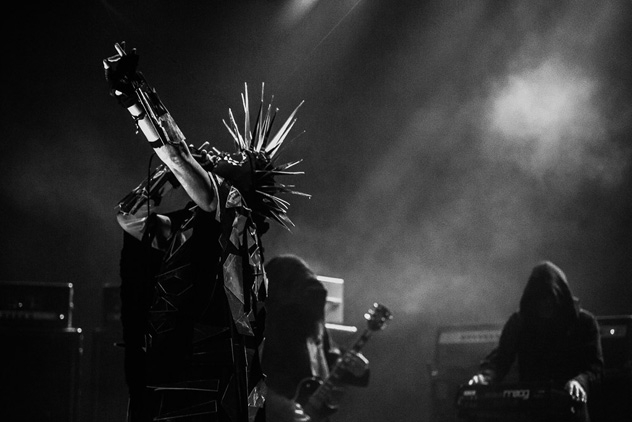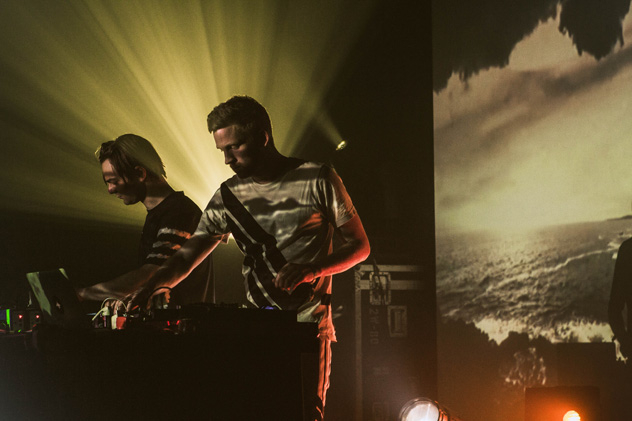- "Trust me, nothing like this ever happens in Knoxville," a friend said in my ear on Thursday night as the 11-piece Sun Ra Arkestra launched into their first number. It was an unexpected setting for a four-day festival of experimental music: a quiet, well-groomed city at the base of the Smoky Mountains in eastern Tennessee. Hip touring bands don't often come through here, given that it's halfway between bustling Nashville to the west and super-hip Asheville to the east. But it's a got a fast-growing urban center—a liberal bubble in the middle of the Bible Belt—and the city seems more than happy to throw its weight behind Big Ears.
The lineup this year spanned high-brow dance music (Andy Stott, Nico Jaar), outré jazz (Sun Ra Arkestra, Kamasi Washington) and drone metal (Sun O))), Mamiffer). There was even a smattering of hip-hop (Shabazz Palaces), noise (Wolf Eyes) and indie rock (Yo La Tengo). Its centerpiece was the Tennessee Theater, a breathtaking 1920s-era movie palace that was refurbished in the early 2000s. There was a smaller theater called the Bijou, and on the other side of Downtown, two more modern venues: the 1,100-capacity Mill & Mine as well as The Standard, an intimate club space. Other small spots—all within walking distance—hosted low-key shows and screenings throughout the weekend.
 Black futurism was one of Big Ears' major themes this year. It started with the Thursday night performance from the Sun Ra Arkestra, whose jubilant cosmic jazz lit up the Mill & Mine. Their set expanded and contracted, moving from catchy choruses to more freeform moments of controlled chaos. Band leader Marshall Allen, a ball of fire at 91 years old, had a remarkable approach to the saxophone, balling up his right fist and mashing it up and down the instrument when things got heated. Towards the end of their set the players took their instruments and danced through the crowd while jamming on an extended rendition of their anthem "Space Is The Place."
Marshall later joined Chicago experimentalist Hieroglyphic Being for an impromptu performance. It was a good idea, highlighting the connection between two generations of star-gazing music from the black diaspora. But they were in their own worlds for much of the performance, Hieroglyphic Being weaving raw techno under Allen's improvisations on saxophone and an electronic wind instrument (or EWI). The former's solo set on Saturday night was much stronger, balancing muscular drum machines with transcendent synths.
Black futurism was one of Big Ears' major themes this year. It started with the Thursday night performance from the Sun Ra Arkestra, whose jubilant cosmic jazz lit up the Mill & Mine. Their set expanded and contracted, moving from catchy choruses to more freeform moments of controlled chaos. Band leader Marshall Allen, a ball of fire at 91 years old, had a remarkable approach to the saxophone, balling up his right fist and mashing it up and down the instrument when things got heated. Towards the end of their set the players took their instruments and danced through the crowd while jamming on an extended rendition of their anthem "Space Is The Place."
Marshall later joined Chicago experimentalist Hieroglyphic Being for an impromptu performance. It was a good idea, highlighting the connection between two generations of star-gazing music from the black diaspora. But they were in their own worlds for much of the performance, Hieroglyphic Being weaving raw techno under Allen's improvisations on saxophone and an electronic wind instrument (or EWI). The former's solo set on Saturday night was much stronger, balancing muscular drum machines with transcendent synths.
 Drone was also at the festival's core. In a little church at the edge of Downtown, Big Ears presented John Luther Adams' Veils and Vesper, an installation that played ambient recordings through different speaker channels encircling the room. It ran for six hours each day as festival goers cycled through the space, lying on the pulpit in the stained glass light or curled up in a pew. The idea was to move around the room to experience different layered "mixes" based on your proximity to one recording or another. After 20 to 30 minutes in one spot it became unclear which timbers and tones were actually changing, and how much of it was just your mind playing tricks.
Sunn O))), the dark princes of drone metal, performed at the Tennessee Theater on Saturday night. Friends have told me about the physical challenge one endures at these shows, and how their whole goal is to hit the "brown note."' This didn't prepare me for the first few thick guitar drones that came from the theater's towering sound system; I was nursing a hangover and almost lost my biscuits and gravy. About 40 minutes in, though, the vibrations and the shifting textures were almost soothing.
Drone was also at the festival's core. In a little church at the edge of Downtown, Big Ears presented John Luther Adams' Veils and Vesper, an installation that played ambient recordings through different speaker channels encircling the room. It ran for six hours each day as festival goers cycled through the space, lying on the pulpit in the stained glass light or curled up in a pew. The idea was to move around the room to experience different layered "mixes" based on your proximity to one recording or another. After 20 to 30 minutes in one spot it became unclear which timbers and tones were actually changing, and how much of it was just your mind playing tricks.
Sunn O))), the dark princes of drone metal, performed at the Tennessee Theater on Saturday night. Friends have told me about the physical challenge one endures at these shows, and how their whole goal is to hit the "brown note."' This didn't prepare me for the first few thick guitar drones that came from the theater's towering sound system; I was nursing a hangover and almost lost my biscuits and gravy. About 40 minutes in, though, the vibrations and the shifting textures were almost soothing.
 Big Ears flirted with house and techno, but they kept it from taking up too much space. The Icelandic duo Kiasmós make records that are melodic and ethereal, but they ramped up the energy for their live show at the Standard on Saturday night. "This is our first time in this part of the world," Ólafur Arnalds told the crowd as he fixed a synth that had been giving them trouble. "There are a lot of churches and McDonalds." Andy Stott, by many accounts the best performance of the festival, took the crowd by surprise. Rather than working his spacey, meditative side to fit the festival vibe, he played some of the clubbiest material you'll ever hear from him.
It's difficult to pull off an event with such wide scope, but Big Ears was a lesson in the art of the crossover. The booking and scheduling really emphasized the connection points between disparate scenes, and encouraged cross-genre collaborations that made those points even more audible. If anything it shuffled dangerously close to the tipping point of eclecticism. But with subtle thematic currents running through the entire program, it managed to hold on to an identity built on futurism, non-conformity and deep listening.
Big Ears flirted with house and techno, but they kept it from taking up too much space. The Icelandic duo Kiasmós make records that are melodic and ethereal, but they ramped up the energy for their live show at the Standard on Saturday night. "This is our first time in this part of the world," Ólafur Arnalds told the crowd as he fixed a synth that had been giving them trouble. "There are a lot of churches and McDonalds." Andy Stott, by many accounts the best performance of the festival, took the crowd by surprise. Rather than working his spacey, meditative side to fit the festival vibe, he played some of the clubbiest material you'll ever hear from him.
It's difficult to pull off an event with such wide scope, but Big Ears was a lesson in the art of the crossover. The booking and scheduling really emphasized the connection points between disparate scenes, and encouraged cross-genre collaborations that made those points even more audible. If anything it shuffled dangerously close to the tipping point of eclecticism. But with subtle thematic currents running through the entire program, it managed to hold on to an identity built on futurism, non-conformity and deep listening.
 Photo credit /
A. Gresham
Chelsea Kornse
Eli Johnson
Jill Sanders
Photo credit /
A. Gresham
Chelsea Kornse
Eli Johnson
Jill Sanders
 Black futurism was one of Big Ears' major themes this year. It started with the Thursday night performance from the Sun Ra Arkestra, whose jubilant cosmic jazz lit up the Mill & Mine. Their set expanded and contracted, moving from catchy choruses to more freeform moments of controlled chaos. Band leader Marshall Allen, a ball of fire at 91 years old, had a remarkable approach to the saxophone, balling up his right fist and mashing it up and down the instrument when things got heated. Towards the end of their set the players took their instruments and danced through the crowd while jamming on an extended rendition of their anthem "Space Is The Place."
Marshall later joined Chicago experimentalist Hieroglyphic Being for an impromptu performance. It was a good idea, highlighting the connection between two generations of star-gazing music from the black diaspora. But they were in their own worlds for much of the performance, Hieroglyphic Being weaving raw techno under Allen's improvisations on saxophone and an electronic wind instrument (or EWI). The former's solo set on Saturday night was much stronger, balancing muscular drum machines with transcendent synths.
Black futurism was one of Big Ears' major themes this year. It started with the Thursday night performance from the Sun Ra Arkestra, whose jubilant cosmic jazz lit up the Mill & Mine. Their set expanded and contracted, moving from catchy choruses to more freeform moments of controlled chaos. Band leader Marshall Allen, a ball of fire at 91 years old, had a remarkable approach to the saxophone, balling up his right fist and mashing it up and down the instrument when things got heated. Towards the end of their set the players took their instruments and danced through the crowd while jamming on an extended rendition of their anthem "Space Is The Place."
Marshall later joined Chicago experimentalist Hieroglyphic Being for an impromptu performance. It was a good idea, highlighting the connection between two generations of star-gazing music from the black diaspora. But they were in their own worlds for much of the performance, Hieroglyphic Being weaving raw techno under Allen's improvisations on saxophone and an electronic wind instrument (or EWI). The former's solo set on Saturday night was much stronger, balancing muscular drum machines with transcendent synths.
 Drone was also at the festival's core. In a little church at the edge of Downtown, Big Ears presented John Luther Adams' Veils and Vesper, an installation that played ambient recordings through different speaker channels encircling the room. It ran for six hours each day as festival goers cycled through the space, lying on the pulpit in the stained glass light or curled up in a pew. The idea was to move around the room to experience different layered "mixes" based on your proximity to one recording or another. After 20 to 30 minutes in one spot it became unclear which timbers and tones were actually changing, and how much of it was just your mind playing tricks.
Sunn O))), the dark princes of drone metal, performed at the Tennessee Theater on Saturday night. Friends have told me about the physical challenge one endures at these shows, and how their whole goal is to hit the "brown note."' This didn't prepare me for the first few thick guitar drones that came from the theater's towering sound system; I was nursing a hangover and almost lost my biscuits and gravy. About 40 minutes in, though, the vibrations and the shifting textures were almost soothing.
Drone was also at the festival's core. In a little church at the edge of Downtown, Big Ears presented John Luther Adams' Veils and Vesper, an installation that played ambient recordings through different speaker channels encircling the room. It ran for six hours each day as festival goers cycled through the space, lying on the pulpit in the stained glass light or curled up in a pew. The idea was to move around the room to experience different layered "mixes" based on your proximity to one recording or another. After 20 to 30 minutes in one spot it became unclear which timbers and tones were actually changing, and how much of it was just your mind playing tricks.
Sunn O))), the dark princes of drone metal, performed at the Tennessee Theater on Saturday night. Friends have told me about the physical challenge one endures at these shows, and how their whole goal is to hit the "brown note."' This didn't prepare me for the first few thick guitar drones that came from the theater's towering sound system; I was nursing a hangover and almost lost my biscuits and gravy. About 40 minutes in, though, the vibrations and the shifting textures were almost soothing.
 Big Ears flirted with house and techno, but they kept it from taking up too much space. The Icelandic duo Kiasmós make records that are melodic and ethereal, but they ramped up the energy for their live show at the Standard on Saturday night. "This is our first time in this part of the world," Ólafur Arnalds told the crowd as he fixed a synth that had been giving them trouble. "There are a lot of churches and McDonalds." Andy Stott, by many accounts the best performance of the festival, took the crowd by surprise. Rather than working his spacey, meditative side to fit the festival vibe, he played some of the clubbiest material you'll ever hear from him.
It's difficult to pull off an event with such wide scope, but Big Ears was a lesson in the art of the crossover. The booking and scheduling really emphasized the connection points between disparate scenes, and encouraged cross-genre collaborations that made those points even more audible. If anything it shuffled dangerously close to the tipping point of eclecticism. But with subtle thematic currents running through the entire program, it managed to hold on to an identity built on futurism, non-conformity and deep listening.
Big Ears flirted with house and techno, but they kept it from taking up too much space. The Icelandic duo Kiasmós make records that are melodic and ethereal, but they ramped up the energy for their live show at the Standard on Saturday night. "This is our first time in this part of the world," Ólafur Arnalds told the crowd as he fixed a synth that had been giving them trouble. "There are a lot of churches and McDonalds." Andy Stott, by many accounts the best performance of the festival, took the crowd by surprise. Rather than working his spacey, meditative side to fit the festival vibe, he played some of the clubbiest material you'll ever hear from him.
It's difficult to pull off an event with such wide scope, but Big Ears was a lesson in the art of the crossover. The booking and scheduling really emphasized the connection points between disparate scenes, and encouraged cross-genre collaborations that made those points even more audible. If anything it shuffled dangerously close to the tipping point of eclecticism. But with subtle thematic currents running through the entire program, it managed to hold on to an identity built on futurism, non-conformity and deep listening.
 Photo credit /
A. Gresham
Chelsea Kornse
Eli Johnson
Jill Sanders
Photo credit /
A. Gresham
Chelsea Kornse
Eli Johnson
Jill Sanders